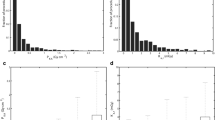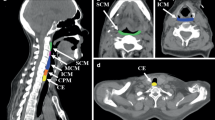Abstract
The purpose of the article is to evaluate the effects of mechanical complications, such as clogging or coiling, of gastrojejunostomy tubes on radiation exposure during exchange in the pediatric population. In this HIPAA-compliant and IRB-approved study, we retrospectively reviewed procedural records for patients undergoing gastrojejunostomy (GJ) tube exchange during a 4-month period in 2014. Success of the procedure, specifications of the tube, age, and sex of the patient as well as radiation exposure during the procedure were included. Radiation exposure was measured in fluoroscopy time and cumulative air kerma. Complications encountered during exchange were also recorded, if available. Patients presenting for gastrostomy to GJ conversions or combined procedures were excluded from the study. Ordinary and mixed effect linear regression models were used to test associations between GJ tube parameters, presence of mechanical complications, and fluoroscopy time and radiation dose. 146 patients undergoing 285 GJ exchanges met inclusion criteria over the 4-month study period (M:F 82:64). All exchanges were successful with 85 demonstrating a form of mechanical complication (44 coiled, 41 clogged). Of the reported GJ tube specifications, only tube length was significantly associated with mechanical complications (p < 0.001). The presence of mechanical complication was significantly associated with increased radiation exposure and fluoroscopy time (p < 0.0001). Mechanical complications of gastrojejunostomy tubes, such as clogging or coiling, are associated with increased radiation exposure during exchange. Strategies to decrease these complications, including re-siting the gastrostomy tract or placement of a surgical jejunostomy in the event of repeated coiling of a tube should be strongly considered.

Similar content being viewed by others
References
Lefton-Greif MA. Pediatric dysphagia. Phys Med Rehabil Clin N Am. 2008;19:837–51. doi:10.1016/j.pmr.2008.05.007.
Prasse JE, Kikano GE. An overview of pediatric dysphagia. Clin Pediatr (Phila). 2009;48:247–51. doi:10.1177/0009922808327323.
Ching YA, Gura K, Modi B, Jaksic T. Pediatric intestinal failure: nutrition, pharmacologic, and surgical approaches. Nutr Clin Pract. 2007;22:653–63. doi:10.1177/0115426507022006653.
Axelrod D, Kazmerski K, Iyer K. Pediatric enteral nutrition. J Parenter Enter Nutr. 2006;30:S21–6. doi:10.1177/01486071060300S1S21.
Fox D, Campagna EJ, Friedlander J, Partrick DA, Rees DI, Kempe A. National trends and outcomes of pediatric gastrostomy tube placement. J Pediatr Gastroenterol Nutr. 2014;59:582–8. doi:10.1097/MPG.0000000000000468.
Livingston MH, Shawyer AC, Rosenbaum PL, Jones SA, Walton JM. Fundoplication and gastrostomy versus percutaneous gastrojejunostomy for gastroesophageal reflux in children with neurologic impairment: a systematic review and meta-analysis. J Pediatr Surg. 2015;50:707–14. doi:10.1016/j.jpedsurg.2015.02.020.
Shah M, Klooster M, Yanni G, Shah A. Frequency and methods of gastrojejunal tube replacement in children. Curr Gastroenterol Rep. 2010;12:223–7. doi:10.1007/s11894-010-0107-2.
Sidhu MK, Goske MJ, Coley BJ, Connolly B, Racadio J, Yoshizumi TT, Utley T, Strauss KJ. Image gently, step lightly: increasing radiation dose awareness in pediatric interventions through an international social marketing campaign. J Vasc Interv Radiol. 2009;20:1115–9. doi:10.1016/j.jvir.2009.07.021.
Pobiel RS, Bisset GS, Pobiel MS. Nasojejunal feeding tube placement in children: four-year cumulative experience. Radiology. 1994;190:127–9. doi:10.1148/radiology.190.1.8259389.
Vitta L, Raghavan A, Morrell R, Sprigg A. Fluoroscopy-guided insertion of nasojejunal tubes in children - setting local diagnostic reference levels. Pediatr Radiol. 2009;39:1203–8. doi:10.1007/s00247-009-1362-y.
Lewis EC, Connolly B, Temple M, John P, Chait PG, Vaughan J, Amaral JG. Growth outcomes and complications after radiologic gastrostomy in 120 children. Pediatr Radiol. 2008;38:963–70. doi:10.1007/s00247-008-0925-7.
Marcuard SP, Finley JL, MacDonald KG. Large-bore feeding tube occlusion by yeast colonies. JPEN J Parenter Enter Nutr. 1993;17:187–90. doi:10.1177/0148607193017002187.
Pearce CB, Duncan HD. Enteral feeding. Nasogastric, nasojejunal, percutaneous endoscopic gastrostomy, or jejunostomy: its indications and limitations. Postgrad Med J. 2002;78:198–204. doi:10.1136/pmj.78.918.198.
Reising DL, Neal RS. Enteral tube flushing: what you think are the best practices may not be. AJN Am J Nurs. 2005;105:58–63. doi:10.1097/00000446-200503000-00024.
Hannah E, John RM. Everything the nurse practitioner should know about pediatric feeding tubes. J Am Assoc Nurse Pract. 2013;25:567–77. doi:10.1002/2327-6924.12075.
Honig SM (2012) Percutaneous feeding tube including a rescue port. US Patent Application No. 13/679,160 filed on November 16, 2012.
Huang SY, Engstrom BI, Lungren MP, Kim CY. Management of dysfunctional catheters and tubes inserted by interventional radiology. Semin Interv Radiol. 2015;32:67–77. doi:10.1055/s-0035-1549371.
Kim CY, Patel MB, Miller MJ, Suhocki PV, Balius A, Smith TP. Gastrostomy-to-gastrojejunostomy tube conversion: impact of the method of original gastrostomy tube placement. J Vasc Interv Radiol. 2010;21:1031–7. doi:10.1016/j.jvir.2010.04.003.
Raval MV, Phillips JD. Optimal enteral feeding in children with gastric dysfunction: surgical jejunostomy vs image-guided gastrojejunal tube placement. J Pediatr Surg. 2006;41:1679–82. doi:10.1016/j.jpedsurg.2006.05.050.
Schlager A, Arps K, Siddharthan R, Rajdev P, Heiss KF. The “omega” jejunostomy tube: a preferred alternative for postpyloric feeding access. J Pediatr Surg. 2016;51:260–3. doi:10.1016/j.jpedsurg.2015.10.073.
Fortunato JE, Darbari A, Mitchell SE, Thompson RE, Cuffari C. The limitations of gastro-jejunal (G-J) feeding tubes in children: a 9-year pediatric hospital database analysis. Am J Gastroenterol. 2005;100:186–9. doi:10.1111/j.1572-0241.2005.40893.x.
Funding
This work did not receive any grant funding or other financial support.
Author information
Authors and Affiliations
Corresponding author
Ethics declarations
Conflict of interest
On behalf of all authors, the corresponding author states that there is no conflict of interest.
Ethical Approval
For this retrospective study, formal consent is not required.
Informed Consent
Does not apply.
Rights and permissions
About this article
Cite this article
Koo, K.S.H., Reis, J., Manchester, J. et al. Effects of Mechanical Complications on Radiation Exposure During Fluoroscopically Guided Gastrojejunostomy Exchange in the Pediatric Population. Dysphagia 33, 251–257 (2018). https://doi.org/10.1007/s00455-017-9854-7
Received:
Accepted:
Published:
Issue Date:
DOI: https://doi.org/10.1007/s00455-017-9854-7




